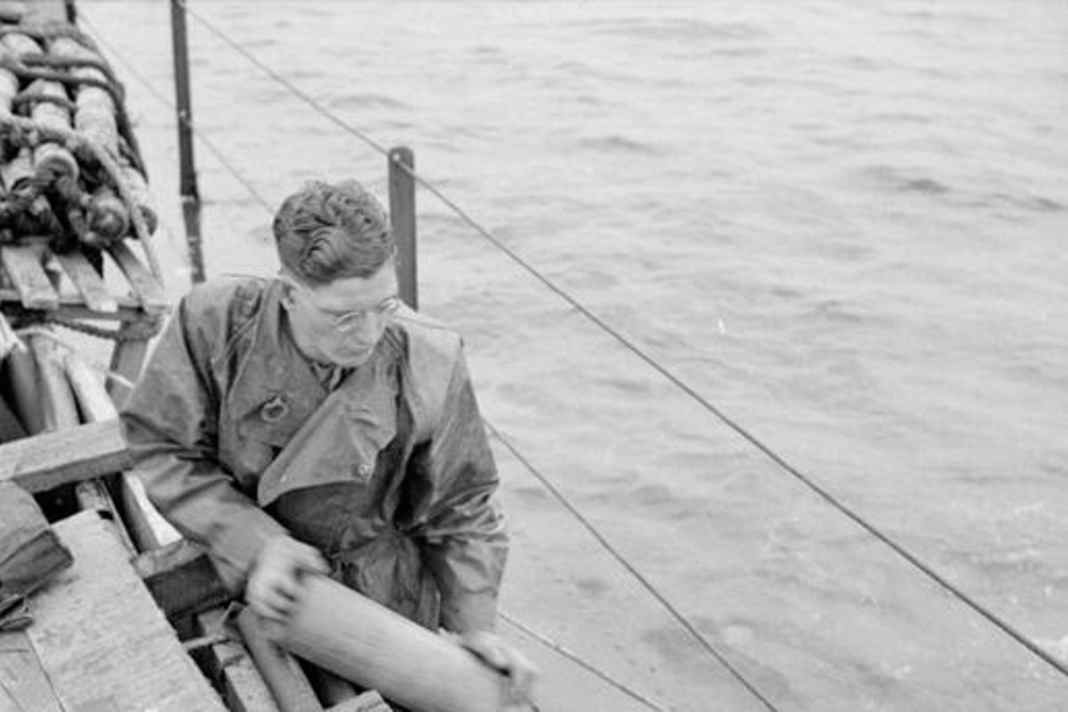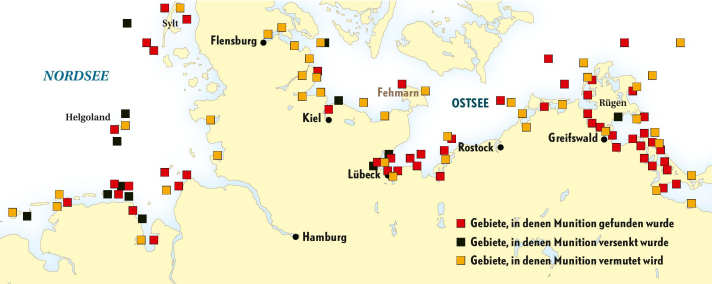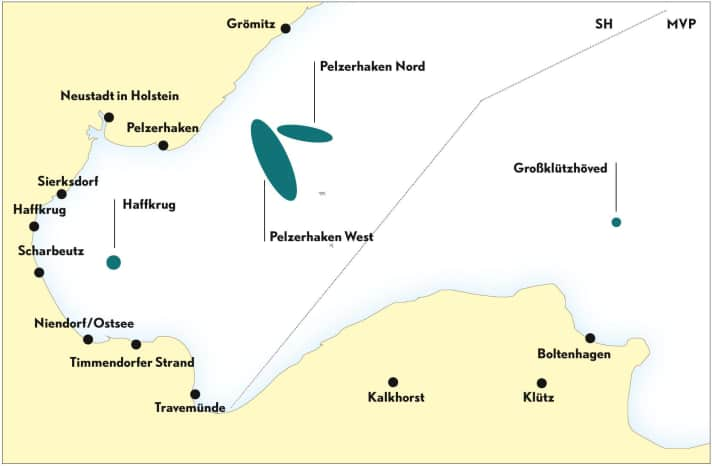Report: How world war munitions are recovered in the North and Baltic Seas
YACHT-Redaktion
· 01.12.2024






- This is how many tonnes of World War II munitions lie in German marine waters
- When can people come into contact with world war munitions?
- When ammunition comes ashore
- A danger to the environment
- What politicians are doing
- How companies get involved in the evacuation
- Findings from the pilot project to clear world war munitions
- Dynamic positioning systems for future clearances
- Pilot project in the Bay of Lübeck
A text by Phillipp Steiner
Looking back: 1945 marks the end of the Second World War. Heaps of ammunition are still stored in many places in Germany. The Allies want to get rid of this dangerous legacy. There was no environmental awareness as there is today. And so hundreds of thousands of tonnes of ammunition are loaded onto ships and dumped in the North and Baltic Seas. Just get rid of the stuff.
Ammunition had already landed in the sea before. Mines were deployed in a targeted manner, torpedoes were fired during battles and manoeuvres, and shells landed on the bottom when a warship was sunk before it could fire them.
This is how many tonnes of World War II munitions lie in German marine waters
Up to 1.6 million tonnes of war munitions are believed to lie in German marine waters. This is according to an inventory carried out by the federal government and coastal states in 2011. Up to 1.3 million tonnes are thought to be in the North Sea and around 300,000 tonnes in the Baltic Sea. The lion's share is made up of conventional munitions, plus a relatively small quantity of chemical warfare agents.
The objects lie in the sea for decades, sometimes over a century. And over time, the explosives become more sensitive to friction and impact, explains Alexander Bach from the Schleswig-Holstein Ministry of the Environment. "Which ultimately means that a smaller weight falling on the explosive is enough to possibly cause it to detonate."
Metal casings protect the explosives from external influences, says Bach, who used to be a mine diver and watch officer in the German Navy. "But when it's rusted through and the explosives are loose in the marine environment, I no longer have this mechanical protection."
When can people come into contact with world war munitions?
People who work in the sea and on shipping lanes can come into contact with ammunition, says Bach. For example, when artillery ammunition lands in fishing nets or in suction dredgers during maintenance work in the Elbe. Also during explorations for offshore projects, where munitions are specifically searched for. Divers could also come across the munitions.
Water sports enthusiasts are not particularly at risk. A detonation is conceivable when anchoring. However, the dangerous areas are marked as "unclean" on the nautical charts, according to the head of the Water Hazard Management Department at the Ministry of the Environment.
Bach is not aware of any accidents in this country in recent years. The last major accident with serious injuries that he remembers occurred off the British coast after a fishing boat picked up old munitions.
When ammunition comes ashore
Ammunition from the sea can also find its way back onto land. Bach estimates the number of incidents on Schleswig-Holstein's coasts at a handful per year. A typical case is that handgun ammunition is washed up on the beach because it is comparatively light.
Cases involving white phosphorus also occur from time to time. This incendiary ammunition is often mistaken for amber, which can lead to severe burns. If the phosphorus combines with the oxygen in the air and heats up - for example in the trouser pocket of a beach tourist - it can ignite spontaneously.
Shortly after the war, people fell victim to the explosive legacies even more frequently. The 2011 inventory records 168 deaths in Germany. Most of the cases occurred in 1945 and 1946 - when the munitions were dumped.
A danger to the environment
In recent years, another danger has come to the fore: the gradual release of hazardous substances from ammunition into the water. When this rots and rusts, it poses a gradual but lasting threat to the environment.
One of the main components of conventional ammunition is trinitrotoluene, or TNT for short. In 2023, Kiel toxicologist Prof Dr Edmund Maser and his colleagues presented an overview study. According to the study, substances such as TNT are known for their toxicity and carcinogenic effects. Numerous studies have measured substances such as TNT and its metabolites in water, sediment and marine organisms. There is increasing evidence that the substances can be harmful. Entry into the food chain is also possible and could have an impact on human health if seafood is consumed. However, consumption can still be considered safe today.
What politicians are doing
While the exact consequences of the munitions continue to be scrutinised in research, politicians have already begun to take action. Federal Environment Minister Steffi Lemke gave the go-ahead for a €100 million immediate action programme in 2023 to initiate the systematic clearance of munitions in the North and Baltic Seas.
It is true that munitions have already been cleared from the sea. However, this has only happened or is only happening occasionally, for example before the laying of pipelines or the construction of wind farms. The munitions are then recovered and disposed of on land. Alternatively, it is relocated at sea, but has also been blown up in the water or on sandbanks.
The German government's immediate action programme is the first to tackle clearance on a large scale. It also aims to make transport on land and blasting at sea superfluous by incinerating the contaminated sites at sea.
The programme therefore focuses on the development and construction of an industrial facility for the disposal of munitions waste at sea, as Dr Wolfgang Sichermann explains. His company Seascape in Hamburg is managing the programme on behalf of the federal government.
The tendering process started in September 2024 and the contract is expected to be awarded in mid-2025, according to Sichermann. The contractor and client will then first define the product together before construction begins. A prototype of the system should be ready by the end of 2026.
How companies get involved in the evacuation
Various companies have indicated in advance that they want to take part. Among them is Thyssen Krupp Marine Systems (tkMS) from Kiel. Product Manager Dr Martin Rütten said in summer 2024 that the company wanted to apply for the federal government's tender for the development and construction of the disposal platform. The Group wants to offer solutions and products for the entire process chain. For example, the autonomous underwater vehicle (AUV) Sea Cat, which the company already sells, could be used to explore the munitions in the sea before the actual recovery.
The current concept envisages a floating platform for disposal, which would be anchored in the deployment area. A crane-operated recovery tool would lift a special pallet out of the water onto which recovery companies would place the explosive ordnance underwater. Delaboration and thermal destruction, i.e. incineration, would follow above water. The Group advertises its expertise, for example in the area of blasting safety. tkMS has its site in Wismar in mind as the location for construction.
For the recovery centre, the Kiel-based company is relying on medium-sized German companies, which will be heavily involved in the construction process. The waste disposal furnaces and other technology such as heating and ventilation will be supplied.
Product Manager Rütten gives an example calculation for the time horizon: "Our platform design will be able to dispose of around 600 tonnes per year. Assuming that half of the 300,000 tonnes of war munitions in the German Baltic Sea are accessible and safe to transport, it would take ten platforms 25 years to recover everything."
The second major German bidder for the federal contract is Rheinmetall. The Düsseldorf-based company has teamed up with WilNor Governmental Services from the Norwegian Wilhelmsen Group. The concept is called EMMA (Entsorgungs Modul Munitions Altlasten).
Rheinmetall does not want to develop the platform from scratch. It is relying on the purchase of a used platform, for example from the oil and gas industry. The disposal system would be installed on it, also used or new, but then a proven type.
"The use of tried-and-tested systems that are available on the market enables an immediate project start and avoids risky new developments," explains Dr Deniz Akitürk, Managing Director of Rhein metall Project Solutions.
"At the moment, so-called innovation partnerships are being discussed for disposal," says Akitürk. "We could start with disposal immediately."
Rheinmetall intends to operate the platform itself at a later date. The defence company would take care of the actual clearance and disposal of the ammunition. The Norwegian partner would cover the maritime and logistical components, according to Akitürk.
Findings from the pilot project to clear world war munitions
Meanwhile, a pilot project on the Baltic Sea has provided findings for the planned systematic clearance. Three positions in the Bay of Lübeck were explored in August 2024, and munitions salvage operations were carried out there from September as part of the federal government's emergency programme.

"For the first time since 1945, war munitions dumped in the sea have been salvaged as a preventive measure to protect people and the environment from harmful explosive compounds," explained spokespersons for the Federal Ministry for the Environment in mid-September.
According to the ministry, the first object recovered was a box containing a 300 gram object: an explosive grenade cartridge that was once intended for an anti-aircraft gun.
As part of the pilot project, the companies SeaTerra (Haffkrug and Pelzerhaken West) and a joint venture between Eggers Kampfmittelbergung and Hansataucher (Pelzerhaken North) are working in the Bay of Lübeck. The sites are located in dumping areas in the coastal waters of Schleswig-Holstein. The base harbour is Neustadt in Holstein.
According to Seascape boss Sichermann, the project has provided insights into the seabed, for example. This proved to be muddier than expected at Pelzerhaken Nord. Magnetometer soundings also showed more anomalies there - indications of possible munitions. This made the search for installation areas for the salvage platform more difficult. The installation areas had to be free of munitions and allow the platform's stilts to remain stable.
Dynamic positioning systems for future clearances
Dynamic positioning systems for the platforms are conceivable for future clearances. In some cases, two two-metre-long ammunition bodies were stuck vertically on top of each other in the mud. "This is a gain in knowledge insofar as you can now get an idea of how it is stored there."
At Haffkrug, the ammunition was placed in a recovery basket using a cable-guided grab, brought onto the platform, identified and inspected. It was then moved back into a so-called wet storage area under water. At Pelzerhaken Nord, the ammunition was moved directly under water using a grab guided by an excavator arm, according to Sichermann.
In the end, the ammunition at both sites ended up in steel containers on the ground in the wet storage areas. The containers were lockable and placed at a safe distance from each other.
Pre-sorting of ammunition in wet storage facilities is intended to ensure a continuous flow of suitable objects once the disposal platform is ready and the ammunition is incinerated on the water surface.
In addition to one recovery platform each, ships were used to transport personnel and materials and to provide security. The companies were there with an "enthusiastic crew", says Sichermann. After all, they were part of a "new era of explosive ordnance clearance".
Pilot project in the Bay of Lübeck

The ammunition lies at a depth of around 20 metres off Pelzerhaken. Before they can be salvaged, all parts are identified and classified using divers and diving robots. They are then placed in watertight containers measuring around three cubic metres, known as wet storage. The risk to the marine environment from the old munitions has already been ruled out. The containers can later be retrieved and brought ashore, where they will be disposed of.

